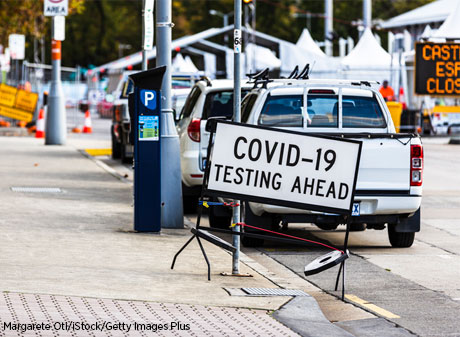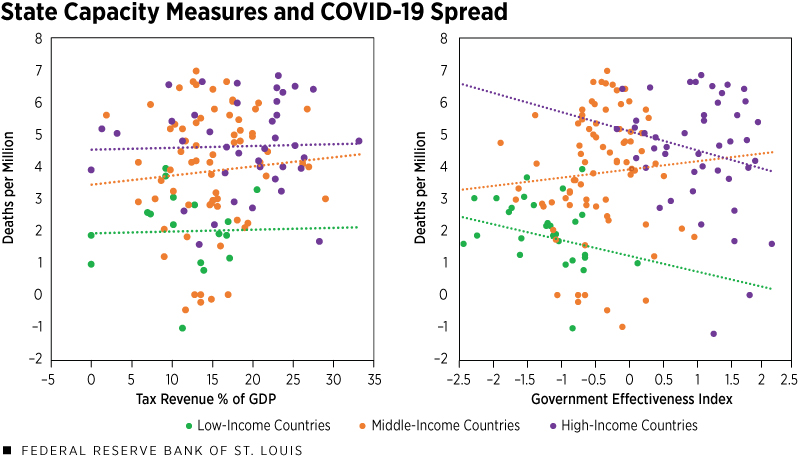Is State Capacity Unrelated to COVID-19 Spread?

A street sign giving directions to a COVID-19 testing site in Hobart, the capital of the Australian island state of Tasmania.
Do countries with higher state capacities have better COVID-19 responses in terms of containing the spread of virus? Not necessarily, according to a recent Regional Economist article.
“State capacity” refers to how effectively a government delivers services to its citizens, the authors explained in the article, which was written by Yi Wen, an economist and assistant vice president; Iris Arbogast, a research associate; and Brian Reinbold, a former research associate. They examined COVID-19 response as a potential revealed measure of state capacity and compared it with two conventional measures.
The authors found that wealthier nations with greater state capacities haven’t necessarily had the best outcomes. In addition, anecdotal evidence from six countries suggests actions taken by a government may have a greater effect on containment than wealth does.
Government Action May Have Affected COVID-19 Spread
The authors looked at the timeline of COVID-19 spread in three countries that had particularly effective responses—Australia, South Korea, and Uruguay—and in three countries that didn’t—Brazil, the U.K., and the U.S.
They noted that these six countries had very few COVID-19 deaths as of March 11, when the World Health Organization declared a pandemic. But soon after, the six countries’ experiences began diverging.
The authors found that total deaths per million were over 600 each in Brazil, the U.K and the U.S. by Oct. 1, while the rate didn’t exceed 35 in the other three countries. (See table below.)
| Total Deaths per Million | ||
|---|---|---|
| Country | By April 15 | By Oct. 1 |
| Australia | 2 | 35 |
| Brazil | 7 | 677 |
| South Korea | 4 | 8 |
| U.K. | 208 | 621 |
| U.S. | 79 | 625 |
| Uruguay | 2 | 14 |
The authors noted that the countries differed in testing and also in implementing social distancing policy measures, such as canceling public events.
“The experiences of these six countries, while anecdotal, suggest that government action may have impacted the spread of the COVID-19 pandemic,” Wen, Arbogast and Reinbold wrote. “If this is the case, COVID-19 would be a potential revealed measure of a country’s state capacity in responding to national emergencies.”
Comparing State Capacity Measures
To that end, the authors examined the relationship between two commonly used indicators of state capacity (tax revenue as a percentage of GDP and a government effectiveness index) and a measure of COVID-19 spread (total deaths per million). The relationship is shown in the figure below.
The authors pointed out that they would expect governments that have higher state capacities to be more successful against the pandemic.
“Instead, there is no relationship between a government’s resource levels and the total number of coronavirus deaths. There is also no statistically significant relationship between the government effectiveness index and total deaths,” they wrote.
Though they found no statistically significant relationship, the authors added that the figure shows a slight negative relationship between government effectiveness and total deaths in high- and low-income countries and a positive relationship in middle-income countries. Furthermore, they noted that high-income countries have had more deaths and cases overall, despite having more resources.
Additional Resources
- Regional Economist: Should Social Distancing Be Mandatory during a Pandemic?
- On the Economy: Learning from Experience: Why Nations May Have Responded Differently to COVID-19
Citation
ldquoIs State Capacity Unrelated to COVID-19 Spread?,rdquo St. Louis Fed On the Economy, March 14, 2021.
This blog offers commentary, analysis and data from our economists and experts. Views expressed are not necessarily those of the St. Louis Fed or Federal Reserve System.
Email Us
All other blog-related questions


